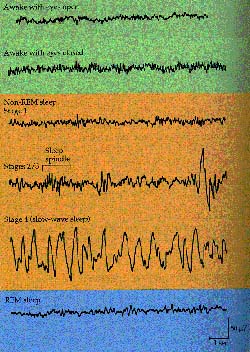|
Sleep - which is defined behaviorally by the suspension of normal consciousness
and electrophysiologically by specific brain wave criteria - consumes
fully a third of our lives.
Sleep occurs in all mammals, and probably
all vertebrates. We crave sleep when deprived of it, and, to judge from animal
studies, continued sleep deprivation can ultimately be fatal. Surprisingly,
however, this peculiar state is not the result of a simple diminution of
brain activity; rather, sleep is a series of precisely controlled brain states, and
in some of these the brain is as active as it is when we are awake. The sequence
of sleep states is governed by a group of brainstem nuclei that project
widely throughout the rest of the brain and modulate overall levels of brain
activity. Despite many advances, major aspects of sleep are still incompletely
understood. The reason for high levels of brain activity during some phases
of sleep, the significance of dreaming, and the basis of the restorative effect
of sleep are all tantalizing puzzles that continue to motivate much ongoing
research.
Teksten er hentet fra boken "Neuroscience", Purves et al., 1997. Sinauer forlag.
|
|

Figur 2
E-post:
Ursula Sonnewald
|

